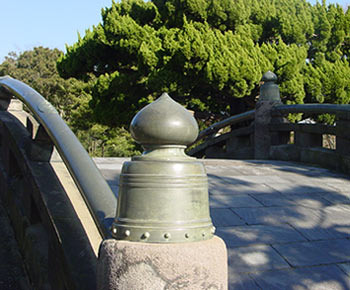Also
pronounced giboushi, giboju, giboushu, goboshu.
A decoration in the shape of the onion-bulb jewel *houju
σμ, found on top of the newel oyabashira e, of railings *kouran
, bridges, and platforms *dan
d. Most commonly made of bronze, they are also made of wood, tile, brass,
shinchuu ^θJ, and iron. The giboshi consists of a cylindrical
column, dou ·, broken by horizontal bands, fushi ί (also shino
Β or *yokoshino
‘Β). Above the column is a rounded base *fukubachi
« or *manjuugata
ι\ͺ`, supporting what is called the jewel pedestal, gyokudai, tamadai
Κδ or gyokuza Κΐ. The jewel pedestal has a narrow neck *kakikubi
ρ, bordered at its top and bottom by narrow bands known as shikiza
~ΐ at the bottom, and *ukeza
σΐ at the top. Above this sits the pointed jewel decoration houju.
A railing decorated in this way is called *giboshi
kouran [σμ. The same type of decoration is found on top of a portable
shrine *mikoshi _`,
but in this case it is known as souka KΤ, and the jewel at the top
is a mani-gem *nyoi houju
@Σσμ. A similarly shaped decoration is also found on lanterns.
|



